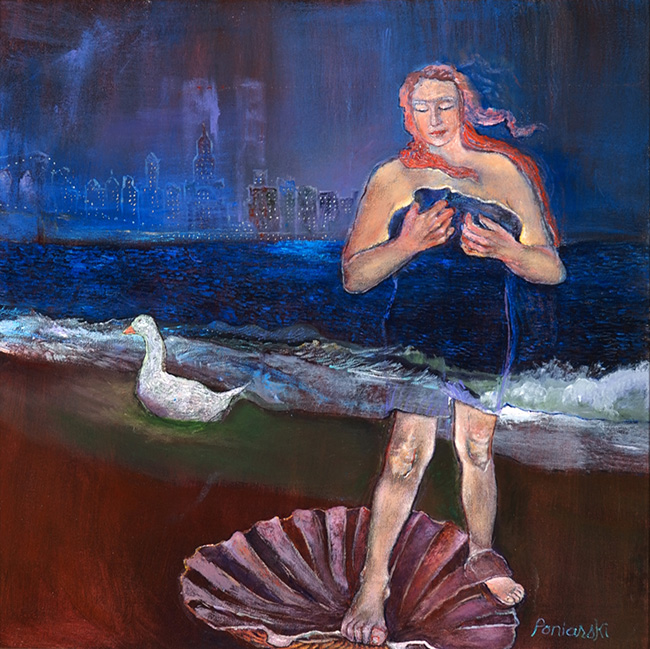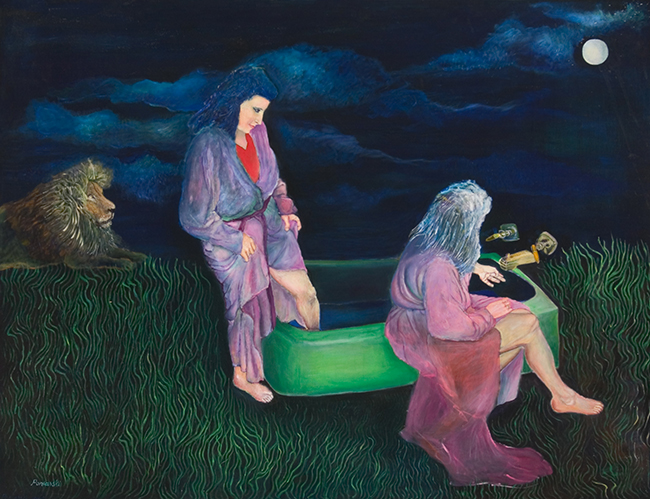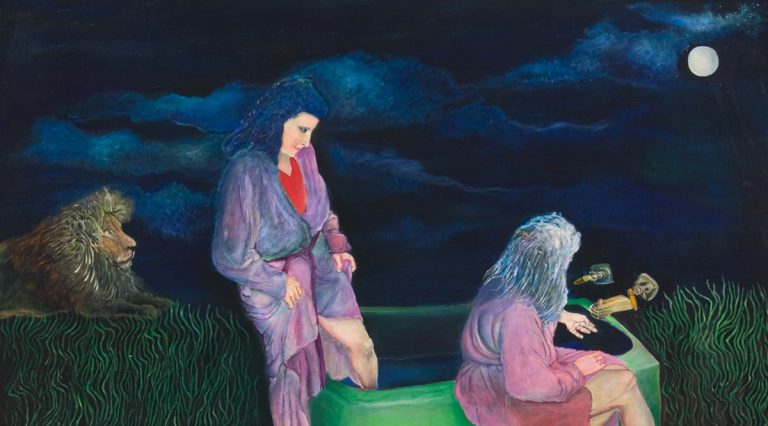Ruth Poniarski came to painting through structure. She began her creative life in architecture, earning her degree from Pratt Institute in 1982. For ten years, she worked in construction, bringing blueprints to life in the physical world. But eventually, lines and measurements weren’t enough. In 1988, she turned to painting—not as a hobby, but as a more open-ended way to think and feel. Where architecture was grounded in rules, painting gave her freedom. She began to build in a new way: with symbols, stories, and inner vision. Her work brings together threads from mythology, literature, philosophy, and history. The result is surreal but specific, intuitive but thoughtful. She invites interpretation, but doesn’t pin anything down.
Let’s look at three of her pieces—The Second Wave, The Birth of Venus, and Bather’s Invention. Each one shows how Poniarski blends imagination with structure, and story with sensation.

The Second Wave feels like a quiet turning point. A wave rises, hinting at change. A lone creature watches as the last shape from the past disappears into the sand. That old mark won’t last—the tide pulls it away—but a second wave is already coming. There’s sadness here, but also momentum. Something is ending, but something else is about to begin. Poniarski paints this shift with soft, almost fluid brushwork, echoing the movement of water. You can sense the rhythms of the sea, but also the cycles of memory and loss. This isn’t just a beach scene—it’s about what happens when something fades, and what follows after.

In The Birth of Venus, the reference is familiar, but the treatment is new. The shell arrives on shore, carried by the ocean, but this Venus doesn’t pose for admiration. She seems to exist in a moment between thought and arrival. There’s breath in the painting—a pause, as if time has stretched. The wave is more than water here; it’s an extension of the universe’s motion. Venus doesn’t just emerge from the sea, she steps out of a dreamlike passage. The painting suggests that beauty isn’t about form alone—it’s also about transition, and what happens when we cross a boundary, internal or otherwise. In Poniarski’s hands, Venus becomes a symbol of that shift, a quiet awakening rather than a grand entrance.

Bather’s Invention takes us into a wooded scene full of layered imagery. There’s a hollow tree, mushrooms, a small waterfall. A lion appears—not roaring, but watchful. Eve is there, adjusting the flow of water, preparing for a ritual. The moon lights the scene, not just for atmosphere, but as a practical source of illumination. There’s something calm and deliberate about the moment. Eve isn’t rushing. She’s tending to the bath, to herself, maybe to the land around her. Poniarski creates a space where nature and human care overlap. Everything seems connected—tree, water, light, animal, person. The painting whispers about cleansing, but also about readiness. It’s not about escape. It’s about being present in the wild, making something out of it.
These three works don’t explain themselves. Poniarski doesn’t use symbols as answers, but as openings. A wave can be time. A bath might be a kind of rebirth. A shell could mark the edge of self-awareness. She pulls from myth because myths are adaptable. They carry meaning, but don’t insist on one reading. That’s how she paints: not to lock things in place, but to give them air.
Her shift from architecture to painting mirrors this approach. One world was about control and plans. The other—her current one—is about suggestion, emotion, and layered thought. Still, you can sense the architect’s mind in the balance of her compositions. But it’s the painter’s hand, and the storyteller’s curiosity, that carries them forward.
Poniarski’s work doesn’t force conclusions. It gives you something to sit with. Something to wonder about. Whether it’s a wave washing over memory or a quiet ritual in the woods, her paintings make room—for questions, for stillness, for the unknown.

